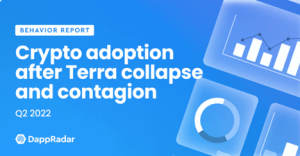crypto investment remains on par despite Terras collapse

The year 2022 has undoubtedly been a bear market, aka crypto winter, with Bitcoin and altcoins losing at one point two thirds of their all-time values. But not all crypto assets have performed equally. There have been a limited number of gainers in addition to the majority of losers.
According to the latest insights from analytics site DappRadar, the real winners during the bear market have been blockchain games which grew by close to 10% since the first quarter. Defying the crypto winter trend, blockchain games also confirmed their status as the industry vertical that is better navigating the bear season.
Despite the Terra debacle, which became the Lehman brothers-like event that sent shockwaves across the crypto industry, DappRadar claims that investors remain bullish. That assumption was reflected, again, in the number of investments into blockchain games and metaverse projects.
The figure has remained constant over a quarterly basis, with $2.5 billion poured into this segment during the six months through June. The latter month, however, recorded the lowest per month investment with only $500 million. Still, its upbeat performance given that Terra collapse erased around $40 billion of VC and retail money.
“We think that blockchain gaming is going to be key in the next two or three years and is going to bring at least a 100 million new users into crypto, for one simple reason, they connect NFTs and DeFi. With all three combined, blockchain gaming, NFTs and DeFi you will see something genuinely new and exciting,” said DappRadars CEO Skirmantas Januskas.
Other highlights show that despite Terras collapse overall blockchain activity remains relatively on par, with users wallet (UAW) activity has fallen by only 7% since Q1. Additionally, the overall transaction count was virtually unchanged from a quarter earlier, but DeFi-related transactions have shrunk by 15% since May.
Per the report, this metric indicates that people continue to engage with blockchain dapps at a more or less the same rate as before the incident. At the same time, the amount of game-related NFT transactions has decreased by 51% since Q1, and the sales volume dropped by 82%.
Another area of weakness was seen in the total value locked, or TVL, a metric that is used to measure the overall health of the DeFi and yielding market. With industry sentiment already bleak, the average loss in TVL among all the blockchains has been a whopping 68%. Some outliers like Harmony, which was already one of the smaller chains that struggled to attract users, lost 76% of its locked assets due to the Harmony bridge hack.
But on the plus side, there’s plenty of optimism around the corner. The report states that metaverse-related NFT projects are a beacon of hope as they reported an overall increase in trading volume and transaction count, up by 97% and 27%, respectively. And despite the previously mentioned setback in NFTs, the global interest in NFTs remains strong.
Many smaller chains paint a more uplifting picture on the other end of the spectrum. Solana grew by 322% last year, while Fantom increased by 455%. Despite being 80% down from its all-time high value, Avalanche is still 1329% up from last year. Solana success is largely down to the fact it attracted many NFTs and game developers mainly due to its cheaper transaction costs and faster processing speeds compared to its rivals, the report concludes.









 Bitcoin
Bitcoin  Ethereum
Ethereum  Tether
Tether  Solana
Solana  USDC
USDC  Lido Staked Ether
Lido Staked Ether  XRP
XRP  Dogecoin
Dogecoin  Toncoin
Toncoin